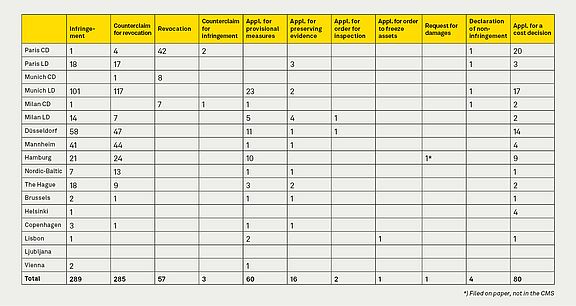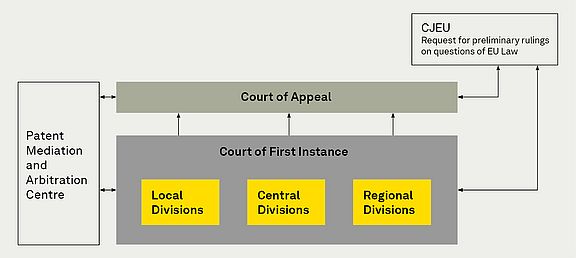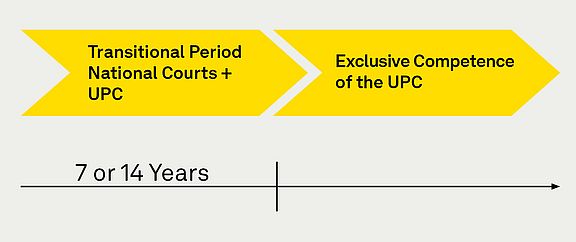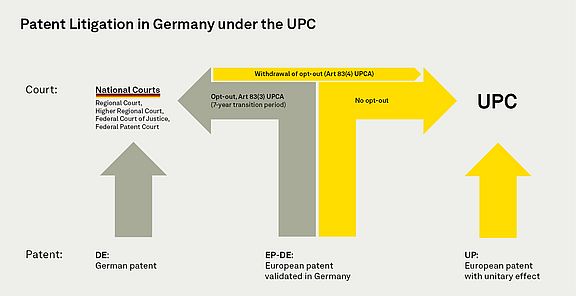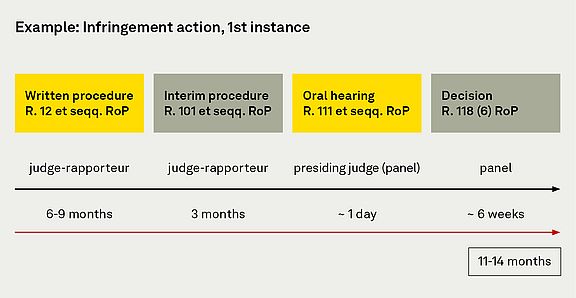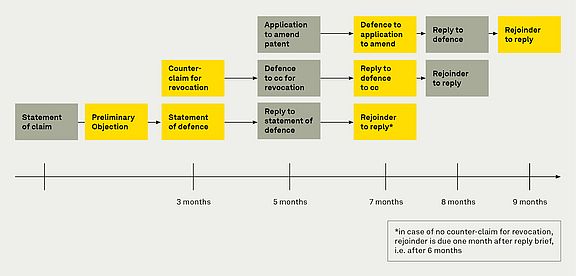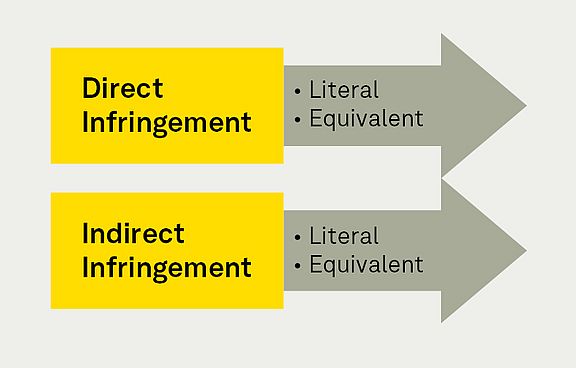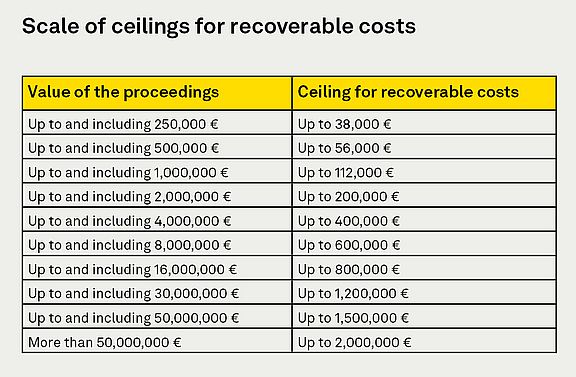Unified Patent Court: Value, Impact & Risks – 10 facts you need to know about the UPC
1. UPC Capital
After almost two years into the UPC, it is fair to say that Munich established itself as the capital of “UPC Land” (cf. 2. below).
To prove this hypothesis, a closer look at the UPC filing statistics, which are published at the UPC’s website on a monthly basis, suffices:
As of April 1, 2025, 101 out of 289 UPC infringement actions were filed with the Local Division in Munich and 117 out of 288 counterclaims for revocation (= nullity). Also, 23 out of 60 UPC preliminary injunction proceedings were brought in this venue. Summarizing, the Munich Local Division had a head start since day one of the UPC and defended its pole position ever since. As of today, it is the only Local Division of the UPC having two panels (and thus the Local Division of the UPC with the most “judge power”). If one adds the central revocation actions pending before the Central Division in Munich, a share of approx. 35% of the entire UPC case load is processed in Munich.
When it comes to the infringement actions, there is a simple explanation for this situation, which can be summarized by “forum shopping” in a “decentralized system”. The “decentralized system” is due to the court structure. The UPC comprises a Court of First Instance and a Court of Appeal, with the Court of First Instance being spread out over 13 Local, 1 Regional and 1 Central Division (with sections in Paris, Milan and Munich). Insofar it is noteworthy that any panel of the Local Divisions in Düsseldorf, Hamburg, Mannheim, Munich, Paris, Milan and The Hague sits in a multinational composition of three legally qualified judges pursuant to Article 8 (3) UPCA. This means that two legally qualified judges are nationals of the Contracting Member State hosting the Local Division concerned and one legally qualified judge who is not a national of such a host state. Other Local Divisions with a lower case load (Brussels, Copenhagen, Helsinki, Lisbon, Ljubljana, and Vienna) only have one national legally qualified judge and two legally qualified judges from other Contracting Member States, see Article 8 (2) UPCA. The Court structure is as follows:
Source: Court Presentation | Unified Patent Court
In essence (and thereby simplifying), the Local and the Regional Divisions of the Court of First Instance are competent for infringement and the Central Division is competent for revocation actions.
When bringing an infringement action, the UPC Agreement allows for “Forum Shopping”, since the plaintiff may either bring the infringement action before the Local Division hosted by the Contracting Member State where the infringement has occurred (Art 33 (1) lit a) UPCA) or before the Local Division hosted by the Contracting Member State where the defendant or, in the case of multiple defendants, one of the defendants has its residence (Art 33 (1) lit b) UPCA). Thus, Art. 33 (1) UPCA establishes a system of “parallel competence” of Local Divisions (Brussels Local Division, order dated March 21, 2025, UPC_CFI_582/2024) and thereby paves the way for “Forum Shopping”. To establish jurisdiction, it is sufficient to provide a plausible allegation that an infringement occurred in that Contracting Member State (it is not necessary to make a conclusive argumentation at this stage; cf. Court of Appeals, order dated September 3, 2024, UPC_CoA_188/2024).
Under Art 33 (1) lit b) UPCA, it is possible to bring the infringement action before the same Local Division against multiple defendants, provided that the defendants have a commercial relationship and that the action relates to the same alleged infringement. The requirements under Art. 33 (1) lit b) UPCA are not as strict as under Art. 8 (1) of the Regulation (EU) n. 1215/2012 (recast) as amended by Regulation (EU) 542/2014 (“Brussels Ibis Regulation”; cf. Brussels Local Division, order dated March 21, 2025, UPC_CFI_582/2024; cf. Duesseldorf Local Division, order dated September 06, 2024, UPC_CFI_165/2024). Thus, the domicile of an “anchor defendant” of a group of companies provides the option to sue the entire group before a Local Division of the Contracting Member State where the “anchor defendant” is domiciled.
Turning back to the question of why Munich established itself as the capital of UPC Land, there are three answers to this question: (1) the judges of the Munich Local Division were transparent about the handling of case management questions since day one, (2) and by this attitude attracted the lion’s share of the cases filed in year 1, (3) thus providing them with the opportunity to shape the UPC’s case law early on and thereby creating predictability for UPC users.
2. UPC Land
The UPC Land now covers 18 countries, i.e., over 340 million people and over 13 trillion USD GDP. For all those UPC Member States, the UPC can grant an injunction based on either the Unitary Patent or European (bundle) patent validated in the UPC Member States. At the same time, the UPC can revoke the European patent for the whole UPC Land.
2.1 UPCA
On June 1, 2023, the Agreement on a Unified Patent Court (UPCA) entered into force and the Unified Patent Court (UPC) opened its doors for 17 EU Member States which signed and ratified the UPCA (UPC Member States) as of June 1, 2023. Those EU Members were Austria, Belgium, Bulgaria, Denmark, Estonia, Finland, France, Germany, Italy, Latvia, Lithuania, Luxembourg, Malta, Netherlands, Portugal, Slovenia, and Sweden. On September 1, 2024, Romania joined the UPC system, becoming the 18th UPC Member State.
2.2 Unitary Patent
As part of the UPC system, patentees can obtain European patents with unitary effect (Unitary Patent) for all UPC Member States. The Unitary Patent can then be enforced in all UPC Member States before the UPC in one infringement action and can be invalidated in all UPC Member States by the UPC in one revocation action.
The Unitary Patent is granted by the European Patent Office (EPO). The granting procedure for the Unitary Patent at the EPO is the same as for the European (bundle) patent since the Unitary Patent is based on it. After the European patent is granted, the patentee can request unitary effect within one month after publication of the mention of the grant of the European patent in the European Patent Bulletin.1
Compared to the European (bundle) patent, no validation processes in various countries are needed with regard to the Unitary Patent. The Unitary Patent also significantly simplifies the payment of annuities as a single renewal fee is payable to the EPO. However, the calculation of renewal fees for the Unitary Patent is based on the “True Top 4” model, e.g., the renewal fees for the Unitary Patent should correspond to the total sum of renewal fees paid for the four most frequently validated countries (DE, FR, NL, UK), irrespective of the fact that the UK has not become a UPC Member State. In this regard, it must be considered that the renewal fees for the Unitary Patent plus the UK part of the European patent are 40% higher than the renewal fees for the German, French and UK parts of the European bundle patent. Therefore, when deciding whether to request unitary effect, the circumstances of the individual case must be taken into account, e.g., countries for which the patentee needs protection, cost assessment, litigation risks etc.
2.3 Competence of the UPC
The UPC has the exclusive competence for infringement and revocation actions concerning the European patents (Unitary Patent and European bundle patent).
With regard to the European bundle patent, there is a concurrent jurisdiction of the national courts during the transitional period of seven years (which may be prolonged for a further seven years). This means that infringement and revocation actions based on the European bundle patent may currently be brought before the UPC and/or national courts. UPC and national proceedings based on the same European bundle patent can be pending in parallel, unless the UPC and national proceedings involve the same cause of action and the same parties.
In addition, the applicant or patent proprietor may exclude the exclusive jurisdiction of the UPC for the European bundle patent up to one month before the end of the transitional period ( “opt-out”). It must be considered that an opt-out is admissible unless an action based on the respective European patent has already been brought before the UPC, Art. 83 (3) UPCA.
The patentee can withdraw its opt-out at any time, unless an action concerning the respective European bundle patent has already been brought before the national courts during the transitional regime, Art. 83 (4) UPCA. While the opt-out secures a patent from a central revocation action at the UPC, it also bears the risk that potential infringers file a national nullity action and thereby prevent the withdrawal of the opt-out and thus a UPC infringement action covering the whole “UPC Land”.
In addition, the jurisdiction of the UPC is not limited to European bundle patents granted after the entry into force of the UPCA. Rather, it also covers European patents granted beforehand and valid for the UPC Member States. The UPCA’s substantive law then applies to acts of infringement (i) committed after the entry into force of the UPCA and (ii) which started before the entry into force of the UPCA and are still ongoing afterwards. Acts of infringement completed before the entry into force of the UPCA are to be assessed based on the national law of the respective country of protection (Mannheim Local Division, decision dated March 11, 2025, UPC_CFI_162/2024).
For the infringement and revocation actions regarding the Unitary Patent, only the UPC is competent.
Patentees who choose the Unitary Patent with the obligatory exclusive jurisdiction of the UPC (instead of the European bundle patent) and who do not want to lose access to national courts may consider filing additional national patents or utility models. German Utility Models, in particular, are an attractive option since they offer cost-efficient protection which can be obtained quickly, within a few weeks from filing at present. However, utility models are only available for products and use claims, but not for process (method) claims. The shorter term of utility models (10 years) is of different relevance, depending on the different life cycles of products in different technical fields.
3. UPC Long Arm
Before the UPC, it is possible to obtain an injunction for up to 39 EPC countries within centralized infringement proceedings against a defendant domiciled in the UPC Land. However, no injunction for third countries like the USA can be granted by the UPC as it is only competent for European patents.
3.1 Injunction for up to 39 EPC countries (if defendant is domiciled in UPC Land)
The UPC has jurisdiction to hear patent infringement actions not only based on the Unitary Patent or the European bundle patent for the UPC Member States but also with respect to other European Patent Convention (EPC) countries where the European patent is in force even if an invalidity defense is raised. However, the UPC’s international competence for the patent infringement actions for other EPC countries (non-UPC Member States) is only given if the defendant is domiciled in the UPC Land, i.e. in one of the 18 UPC Member States (Art. 4 (1), Art. 71b no. 1 Brussels Ibis Regulation). An infringement action including injunction and damages for the UPC Land and other EPC countries in which the European patent is validated must be brought before the local division of the UPC Member State where the defendant has its residence, Art. 33 (1) b) UPCA. With regard to defendants domiciled in Germany, all German Local Divisions are competent.
The judgment of the Court of Justice of the European Union (CJEU) of February 25, 2025 – C-339/22 (BSH./.Electrolux) confirms the long-arm jurisdiction of the UPC (that is deemed to be a court of an EU Member State according to Art. 71a (1) Brussels Ibis Regulation) for patent infringement actions with respect to other EPC countries. The judgment of the CJEU brings long-awaited clarity with regard to the long-arm jurisdiction and strengthens cross-border patent litigation options.
Concerning the question of validity, it must be differentiated between (i) EU Member States which are non-UPC Member States and (ii) EPC countries which are non-EU Member States.
(i) EU Member States which are non-UPC Member States
Even if the UPC is competent for infringement actions regarding acts of infringement in the EU Member States which are non-UPC Member States, the national courts of the EU Member States which are non-UPC Member States and where the patent is validated, shall have the exclusive competence for the question of validity of those parts of the European patent (Art. 24 no. 4 Brussels Ibis Regulation). According to the CJEU, the infringement action may be stayed in view of an invalidity defense to consider a decision on the validity of national courts of other EU Member States which are non-UPC Member States.
(ii) EPC countries which are non-EU Member States
According to the CJEU’s judgment, a court of the EU Member State where the defendant is domiciled is also competent for an infringement action concerning the acts of infringement in EPC countries which are non-EU Member States. This court may even have competence to decide on the invalidity defense with regard to those parts of the European patent with inter partes effect, i.e. a scope limited to the parties to the proceedings. The reason for the different assessment of the validity compared to EU Member States is that Art. 24 no. 4 Brussels Ibis Regulation does not apply with regard to non-EU Member States2.
However, in order to argue that the patent-in-suit is invalid before the UPC, the defendant must file a counterclaim for revocation (Art. 65 (1) UPCA). Without filing a counterclaim, the invalidity defense does not need to be addressed by the UPC (Vienna Local Division, decision dated January 15, 2025, UPC_CFI_33/2024). A decision on the counterclaim for revocation (in principle, see below) has erga omnes effect and is not limited to the parties to the proceedings.
It remains to be seen whether the UPC – re. non-EU Member States – will allow an “exception” to the rule of (formally) having to file a counterclaim “for revocation” and would also consider a mere invalidity defense (with inter partes effect)3 or if it will decide that a counterclaim can have inter partes effect regarding the non-EU Member States4. As a decision by the UPC on validity with erga omnes effect is in no case possible for those parts of the European patent which are validated in non-EU Member States (and more broadly: non-UPCA Member States), the defendant may file a revocation action before the national courts of the non-UPCA Member States or initiate the EPO opposition proceedings (if the 9-month time window for filing an opposition is still open), to ultimately gain legal certainty, e.g., for group members or suppliers and customers. A stay of the UPC infringement proceedings re. non-EU Member States may, however, be unlikely in this scenario, given that the UPC can itself adjudicate validity with inter partes effect.
Cross-border constellations are already known in the case law of the UPC. The Düsseldorf Local Division accepted its jurisdiction inter alia for an infringement action with regard to the UK part of the European patent even before the judgment of the CJEU was issued (decision dated January 28, 2025, UPC_CFI_355/2023). Later, the Milan Local Division applied the principles of international jurisdiction as clarified by the CJEU and decided that it is also competent to decide on an infringement action concerning those parts of the European patent which are validated in non-UPC Member States, e.g., in Spain, against the defendant domiciled in Italy (final order dated April 8, 2025, UPC_CFI_792/2024 App. 61708/2024). Furthermore, the Paris Local Division confirmed its competence for infringement actions based on the European patent which is validated inter alia in Spain, Switzerland, and UK (order dated March 21, 2025, UPC_CFI_702/2024).
Importantly, the long-arm jurisdiction of the UPC extends only to the EPC countries as the jurisdiction of the UPC is limited to the Unitary Patents and/or European patents (Art. 2 (g), Art. 32 (1) UPCA). The UPC is thus not competent for infringement actions with regard to the third countries which are non-EPC countries, e.g., the USA.
3.2 Damage arising outside the EU (if defendant is domiciled outside of the EU and Lugano Convention)
In the proceedings concerning an infringement of the Unitary Patent and/or the European bundle patent against a defendant who is neither domiciled in an EU Member State nor in a Member State of the Lugano Convention (e.g., Switzerland)5, the UPC can still have international jurisdiction in relation to damages arising outside of the EU, e.g., in the UK (Art. 71b No. 2, No. 3 Brussels Ibis Regulation).6 To establish a long-arm jurisdiction of the UPC for damage suffered outside of the EU, further requirements must be met: Property belonging to the defendant has to be located in any UPC Member State and the dispute must have a sufficient connection with any such UPC Member State.
However, the UPC’s competence for injunctive relief in such cases is limited to the UPC Land based on the Unitary Patent and/or parts of the European bundle patent validated in the UPC Member States.
4. UPC Rocket Docket
The UPC provides high-quality and quick decisions in proceedings for preliminary injunction and main actions. A first-instance decision in a main action takes 406 days (average after year 1), and 96 days for preliminary injunctions (average after year 1). The timeline for appeal proceedings is similar.
4.1 Timeline in the main proceedings
The Preamble of the Rules of Procedure (RoP) emphasizes that the final oral hearing on the issues of infringement and validity at first instance shall typically take place within one year. Depending on the complexity of an action, it may require more or less time. A decision can be then issued up to 6 weeks after the oral hearing.
Based on the Annual Report 2024 of the UPC, a decision in an infringement action in the first-instance proceedings is issued on average in 406 days, and in a revocation action in 384 days. Therefore, the timeline as intended by the RoP is basically met in most cases.
In general, proceedings before the UPC Court of First Instance consist of the following stages:
- a written procedure,
- an interim procedure, and
- an oral procedure.
The RoP include specific provisions for the written procedure for different types of proceedings. For a (main) infringement action and a counterclaim for revocation, the following deadlines apply to ensure that an oral hearing takes place within one year:
4.2 Time extension requests
Theoretically, it is possible to request a time extension for the deadlines as specified by the RoP. However, the UPC is rather reluctant to grant time extensions due to the strict deadline regime of the RoP. Therefore, time extensions are typically granted only under exceptional circumstances.
Filing confidentiality requests including a restriction of access to specific persons of the other party according to R. 262A RoP typically leads to discussions on the confidentiality club (i.e. persons who should have access to confidential information of the other party) between the parties. This provides an option for delay and could lead to time extensions and a later oral hearing.
4.3 Additional submissions
The UPC system is not only strict with regard to the deadlines but also with regard to the possibility to file additional submissions. The written procedure is limited to the submissions expressly mentioned in the RoP. Before the conclusion of the written procedure, a further exchange of written pleadings may be allowed by the judge-rapporteur only upon a reasoned request by a party. After the conclusion of the written procedure, no further exchange of written submissions is provided in the RoP. However, the UPC may issue a procedural order according to R. 9 RoP or R. 332 RoP at any stage of the proceedings to direct a party to take a specific step, answer a question, or provide clarification or evidence. This could be done based on a reasoned request by a party or on the court’s own motion.
4.4 PI proceedings
A decision in the first-instance proceedings for provisional measures (PI proceedings) can be expected in 3-4 months, i.e. more than 9 months earlier compared to the main proceedings.
In the PI proceedings, the applicant has to prove that
- the applicant is entitled to initiate proceedings,
- the patent is valid,
- the patent is infringed,
- the requirement of urgency is fulfilled, and
- the balance of interests is in favor of the applicant.
Regarding the first three requirements (entitlement, validity and infringement), a prima facie analysis is required. The applicant has to prove these requirements with “a sufficient degree of certainty”, i.e. “at least more likely than not” (>50%). However, the defendant bears the burden of proof that the patent is not valid in inter partes PI proceedings.
With regard to the urgency requirement and weighing of interests, the applicant’s burden of proof is higher and is not limited to prima facie analysis. Concerning urgency, the applicant should prove its need for an early and prompt decision to avoid further damage resulting from deciding the case in the main proceedings. The UPC considers whether the applicant acted negligently or hesitated in requesting PI after gathering all the necessary information to prepare its action from the objective point of view, i.e. how long did it take for the applicant to file a PI. In this regard, there is deviating case law of different UPC local divisions.7 Also, the factual circumstances must be considered when assessing the urgency requirement.
If a PI is granted as requested, the applicant has to file a main infringement action within a time period not exceeding 31 calendar days or 20 working days, whichever is the longer period, from the date specified by the UPC in its order. If the applicant does not file a main action, the UPC shall revoke the PI upon request of the defendant.
5. UPC Infringement Test
The UPC applies an infringement test that is very similar to the one that has been practice in Germany for decades. In short, claim features are given their “broadest meaningful interpretation” which focuses on their technical function in the context of the technical problem solved by the invention.
When it comes to the UPC’s infringement test, it is important to note that the same test is applied for European bundle patents and Unitary Patents. Thus, the UPC applies an autonomous interpretation of Art. 25 UPCA (direct infringement) and Art. 26 UPCA (indirect infringement):
The UPC’s claim construction principles for literal infringement are already on solid ground (Court of Appeal, Order of 26 February 2024, UPC_CoA_335/2023; Order of 25 September 2024, UPC_CoA 182/2024; Central Division Munich, Decision of 16 July 2024, UPC_CFI_1/2023) whereas infringement under the doctrine of equivalence was only dealt with in detail by The Hague Local Division in its decision of 22 November 2024, UPC-CFI_239/2023.
In a nutshell, the UPC applies a broad German-style claim construction approach (“broadest meaningful interpretation”) that can be summarized as follows (cf. Duesseldorf Local Division, decision dated October 31,2024, UPC_CFI_373/2024):
- The claim is not only the starting point but also the decisive basis for determining the scope of the protection conferred by the European patent. The claim must not be interpreted solely on the basis of the literal meaning of the wording used, but the description and the drawings must always be consulted as aids to interpretation and not only to resolve any ambiguities in the patent claim.
- The claim must not be limited to the scope of preferred embodiments. The scope of a claim extends to subject matter that the skilled person understands as the patentee’s claim after interpretation using the description and drawings. A claim interpretation which is supported by the description and drawings as a whole is generally not limited by a drawing showing only a specific shape of a component.
- A feature in a patent claim must always be interpreted in the light of the claim as a whole.
- From the function of the individual features in the context of the patent claim as a whole, it must be deduced what technical function these features actually have individually and as a whole.
- The description and the drawings may show that the patent specification defines terms independently and, in this respect, may represent a patent’s own lexicon. Therefore, even if the terms used in the patent deviate from common usage, it may therefore be that the meaning of the terms resulting from the patent specification is ultimately authoritative.
- The patent claim must be interpreted from the point of view of a person skilled in the art.
6. UPC Remedies
Thus far, the UPC can be described as a system where an injunction follows regularly once the patent-in-suit is found to be valid and infringed. The UPC also offers a one-stop shop for damage awards. While the first precedent how to calculate damages has yet to be set, it will certainly be established within the next year or two.
If the UPC finds that the patent-in-suit is valid and infringed, it will – upon plaintiff’s request – grant the following remedies:
- Permanent injunctive relief (Art. 63 UPCA)
- Corrective measures like recall and destruction (Art. 64 UPCA)
- Rendering of information (Art. 67 UPCA)
- Damages (Art. 68 UPCA)
Under the current UPC case law and absent a decision of the Court of Appeal, the UPC interprets Art. 63 UPCA in a narrow manner and thereby establishes a system of automatic permanent injunctive relief. Pursuant to Art. 63 UPCA, the court has discretion to grant the permanent injunction (Art. 63 (1) UPCA “may”). Thus, as a starting point, the circumstances of the individual case must be taken into account in order to assess whether in the particular case at hand an injunction would be disproportionate (Art. 42 UPCA). The burden of demonstration and proof lies on the infringer relying on disproportionality (Art. 54 UPCA).
Pursuant to the current UPC case law, arguing disproportionality is a high hurdle for the defendant (cf. Mannheim Local Division, Decision of 2 April 2025, UPC_CFI_365/2023) which has not been met so far in any UPC main action. For UPC preliminary injunction proceedings, the situation is different (cf. Düsseldorf Local Division, Order of 31 October 2024, UPC_CFI_368/2024).
The starting point of the current case law is that any restriction to the claims for injunctive relief affects the patent owner’s exclusive right pursuant to Art. 25 UPC which is in any case only awarded for a limited time period. That said, a restriction on the grounds of disproportionality is at least for the time being and absent any authority from the Court of Appeal limited to exceptional cases where the interest of the infringer clearly outweighs the interest of the patent owner.
Whether the UPC will be an attractive venue for damage awards still remains to be seen. The main provision for the calculation of damages is Art. 68 UPCA which provides the court with two options:
- (a) the court shall take into account all appropriate aspects, such as the negative economic consequences, including lost profits, which the injured party has suffered, any unfair profits made by the infringer and, in appropriate cases, elements other than economic factors, such as the moral prejudice caused to the injured party by the infringement; or
- (b) as an alternative to point (a), the court may, in appropriate cases, set the damages as a lump sum on the basis of elements such as at least the amount of the royalties or fees which would have been due if the infringer had requested authorization to use the patent in question.
Both options involve many questions of judgment rather than precision and the UPC community is still lacking a precedent from the UPC Court of First Instance in relation to this Article. Thus, it is currently very speculative how this provision will be applied (this also applies to the question whether punitive aspects will be part of the damage calculation, without damages being punitive as such according to Art. 68 (2) UPCA).
Irrespective of the application of Art. 68 UPCA, the UPC offers the patentee a “one-stop-shop” option for recovering damages which is a big advantage compared to the previous situation of a “country-by-country” damage recovery before the UPC Agreement entered into effect. A damage claim may not be brought before the UPC more than five years after the date on which the applicant became aware, or had reasonable grounds to become aware, of the last fact justifying the action (cf. Art. 72 UPCA).
In the typical scenario where the patentee is unaware of the scope of the infringement, the determination of the amount of damages will be the subject of separate proceedings. To pursue its damage claims, the successful party shall lodge a corresponding application no later than one year from service of the final decision on the merits on both infringement and validity.
7. UPC Enforcement
UPC decisions “may” be subject to the rendering of a security (whether by deposit, bank guarantee, or otherwise). The security shall compensate the losing party for any damage incurred or likely to be incurred by if the UPC decision is enforced and subsequently revoked.
An injunction without the provision of security for enforcement is, however, not rare at the UPC. Security for enforcement was ordered only in 17% of the (main) infringement actions and in 57% of the preliminary injunction proceedings (as of April 30, 2025).
The UPC may order security for enforcement according to R. 352, R. 118.8, R. 211.58 RoP, if the financial position of the claimant (“good for the money”) or the enforcement law of the country where the claimant is domiciled gives rise to concern that difficulties would be expected in connection with the enforcement of any possible damages (Local Division Munich, order dated September 19, 2023, UPC CFI 2/2023; order dated August 27, 2024, UPC_CFI_74/2024). The request for enforcement security must be substantiated by the defendant. The Local Division Düsseldorf applied a different approach and decided that enforcement security should normally be ordered in the PI proceedings due to the preliminary assessment, unless the specific case exceptionally requires otherwise (order dated October 31, 2024, UPC_CFI_368/2024).
The amount of enforcement security should cover the costs of the proceedings, other costs arising from the enforcement, and any compensation for damage suffered or likely to be suffered due to the enforcement. As it is difficult for the court to calculate the estimated damages, enforcement security is based on the value in dispute, unless the defendant provides detailed information on the potential harm during the enforcement period.
8. UPC Invalidity Risks
The UPC system offers defendants the opportunity to attack the patent-in-suit from various angles. These attacks are “central” in the sense that they cover all countries in which the patent-in-suit has effect. The invalidation applies not only with inter partes but with erga omnes effect.
8.1 Central revocation action and counterclaim for revocation
For the patentee, the route to the UPC has the advantage that it can enforce the Unitary Patent and the European bundle patent in one single procedure with effect in all UPC Member States. While this increases the economic impact of the patent, it implies at the same time the inevitable risk that the patent may be invalidated in one single procedure for its whole territory, be it in isolated central revocation action, be it in infringement proceedings in which a counterclaim for revocation has been raised (“all eggs in one basket”).
Moreover, the Unitary Patent and/or the European bundle patent can be attacked with a counterclaim for revocation in response to an infringement action and a central revocation action in parallel.
The situation of the dualisms of a central revocation action and a counterclaim for revocation can arise in the following scenarios:
- Filing a central revocation action at the UPC central division by one legal entity before an infringement action was initiated and subsequent filing of a counterclaim for revocation by another legal entity (for example from the same group of companies) after the infringement action against the latter legal entity was brought before a local or regional division;
- Filing a central revocation action (by a third party other than the counterclaimant) at a central division and a counterclaim for revocation after an infringement action before the local or regional division was initiated.
Concerning the counterclaim for revocation, the local or regional division can proceed with both infringement action and counterclaim for revocation, refer the counterclaim for revocation to the central division, or refer the entire case (i.e. infringement action and counterclaim for revocation) to the central division with the agreement of the parties. When exercising its discretion, the local or regional division shall consider how far the central revocation action was advanced.
If the local or regional division refers the counterclaim for revocation to the central division, the central division may order that the central revocation action and the counterclaim for revocation are heard together. However, this does not result in a true merger of claims (in particular due to the different parties involved in the proceedings).
8.2 Parallel EPO opposition proceedings
The risk of invalidation of the Unitary Patent and/or European bundle patent increases since parallel invalidity proceedings before the UPC and the EPO are possible. Unlike under German law, the EPO opposition proceedings do not block the possibility of filing a revocation action at the UPC.
In general, the UPC may stay its proceedings in view of pending EPO proceedings under certain circumstances, but will probably not do so as parallel invalidity proceedings before the UPC and the EPO are intended by the legislator (Court of Appeal, Order of 28 May 2024, UPC_CoA_22/2024)9.
What happens if the assessment of validity by the UPC and the EPO will be different?
- An invalidity decision of the EPO would overrule any decision of the UPC confirming the validity, and vice versa (Court of Appeal, order dated May 28, 2024, UPC_CoA_22/2024).
- If the UPC upholds the Unitary Patent and/or the European bundle patent for the UPC Member States to a certain extent with certain limitations (e.g., A and B) and the EPO upholds it with other limitations (e.g., C), then in an infringement action at the UPC based on the Unitary Patent or the parts of the European patent for the UPC Land, one would have to consider all limitations under both the UPC and the EPO, i.e., A, B and C.
8.3 Parallel national nullity proceedings
With respect to the European bundle patent10, there is a concurrent jurisdiction of the UPC and national courts during the transitional period of seven years (which may be prolonged with further seven years), meaning that revocation actions may be brought before the UPC and/or national courts of the UPCA Member States. Therefore, parallel national and UPC revocation proceedings concerning the same European patent are in general possible.
However, the provisions of Brussels Ibis Regulation, i.e. Art. 29 to 32, which are aimed at minimizing the parallel proceedings before the courts of different EU Member States to avoid potential conflicts between decisions of different courts, must be considered (R. 295 lit. l) RoP).
- If the UPC proceedings involve the same cause of action and the same parties (i.e., same legal entities) as an action already brought before a national court of the UPC Member State, the UPC shall stay its proceedings. This applies even if the proceedings before a national court of the UPC Member State were initiated before the transitional period (Court of Appeal, Order of 17 September 2024, UPC_CoA_227/2024).
- If a related action is pending in a national court, the UPC may stay its proceedings. A decision about the stay of the proceedings is at the discretion of the court, and the following considerations must be taken into account. Although parallel EPO opposition and UPC proceedings are intended by the legislator and the UPC will probably not stay its proceedings due to the pending EPO proceedings, parallel proceedings between different courts must be minimized (Court of Appeal, order dated September 17, 2024, UPC_CoA_227/2024). Other relevant aspects for a decision on the stay of the UPC proceedings are the degree of identity of the cause of action (e.g., which parts of the European patent are attacked in both actions), closely related parties in the national and UPC proceedings (e.g., the same group of companies), and a more advanced stage of the national invalidity proceedings.
9. UPC Costs
UPC infringement actions offer very good value for money. This statement holds true from all angles, namely (i) a comparison between UPC and national EU patent litigation, (ii) a comparison between UPC and UK patent litigation, and (iii) a comparison between UPC and US patent litigation:
- The costs associated with UPC litigation are more significant when compared to a single continental EU patent litigation action. However, this comparison is inherently flawed as a UPC decision can cover up to 18 UPC Contracting Member States, whereas a national court decision only covers the territory of the national court seized. If one were to compare multiple (e.g., 5 or more), let alone 18, national patent infringement actions with one UPC action, the single UPC action would be much more economical than the separate national enforcement.
- UPC litigation is also very cost efficient if compared to UK national patent litigation. The reason for this is threefold: (1) in UPC proceedings, only UPC representatives are active, whereas no specific trial court attorneys (in the UK: barristers) must be retained, (2) the role of experts is more limited and the UPC’s trial format is more condensed to a one-day trial compared to a several-day trial in the UK, and (3) the territorial reach of a UPC decision is much broader if compared to a national UK finding of infringement.
- Also, if compared to US District Court patent litigation, the UPC is an attractive option from a financial perspective. This is due to the lack of the cost drivers known from US patent litigation, namely extensive discovery and lengthy proceedings.
The main costs for UPC proceedings are associated with attorneys’ fees since the court fees are very moderate and less than 50,000 EUR in a standard matter. However, when it comes to the cost risk entailed by UPC litigation, cost reimbursement must be factored in. The UPC is based on a “loser pays” approach, whereby the loser must not reimburse the actual fees incurred, but only “reasonable fees up to a certain ceiling” (cf. R. 152.1 and .2 RoP). This ceiling is determined by the value of the proceedings, which is set by the court based on the plaintiff’s proposal and which shall reflect the objective interest pursued by the filing party at the time of filing the action (cf. R. 370.6 RoP). The ceiling amounts are quite significant, but it must be borne in mind that the value of the proceedings comprises both the value for the infringement action and the counterclaim for revocation:
The ceilings furthermore only apply to the costs for representation, while reasonable expenses for prior art research, translations, travel and outside experts come on top.
In light of this “loser pays” system, which can result in significant six or seven digit reimbursement claims, the UPC Rules provide for a system that the court may (discretion) order at any time during the proceedings following a reasoned request by one party, the other party to provide, within a specified time period, adequate security for the legal costs and other expenses incurred and/or to be incurred by the requesting party, which the other party may be liable to bear (cf. R. 158 RoP). If such a request is granted by the court, comparatively early in the proceedings such cost security is to be provided by way of a deposit or bank guarantee (as ordered by the court). When exercising its discretion under R. 158 RoP, the Court must determine, in light of the facts and arguments brought forward by the parties, whether the financial position of the party gives rise to a legitimate and real concern that a possible order for costs may not be recoverable and/or the likelihood that a possible order for costs by the court may not, or in an unduly burdensome way, be enforceable (cf. Court of Appeal, Order of 22 May 2024, UPC_CoA_221/2024). Pursuant to the Court of Appeal, the relative financial position of the plaintiff as compared to that of the defendant is not as such a criterion pursuant to R. 158 RoP, especially where the (limited) level of funding provided to a special-purpose patent enforcement entity is a deliberate business decision.
10. UPC Success Rates (Court of First Instance)
The UPC case load has been continuously increasing since its inception and this is certainly due to the UPC’s success rates for plaintiffs. Of course, the current snapshot of the success rates is incomplete for many reasons and at least three caveats must be made: (1) the empirical basis of any UPC success rate statistics is very limited; (2) many actions are still pending with the Court of Appeal, which may overturn the Court of First Instance, and last but not least (3) for various actions, parallel opposition proceedings are pending with the European Patent Office, which could ultimately fully or partially invalidate the patents-in-suit and thereby change the outcome of the pending UPC actions.
With that all borne in mind, the following picture emerges:
- As of April 2025, 56% of all main infringement actions decided by the Court of First Instance ended in favor of the plaintiff. In 64% of cases where the defendant was successful, this success was based on the patent-in-suit being revoked in its entirety. As mentioned above, in only 17% of the successful cases, an enforcement security was ordered pursuant to R. 352 RoP. This means that the orders granted by the court were, de facto, immediately enforceable after the plaintiff had notified the court which part of the orders they intended to enforce (R. 118.8 RoP).
- Interestingly, the success rate for preliminary injunction proceedings is similar and amounts to 50%. This result is surprising when comparing it to national preliminary injunction proceedings where lower success rates are common. Unlike the main actions, in 57% of the successful cases an enforcement security pursuant to R. 352 RoP was ordered. The amounts ordered were, however, at the lower end and amounted to an average of EUR 1.1 million.
Footnotes
- Alternatively, the patentee may already request the unitary effect after the issuance of the decision to grant the European patent. In the latter case, the patentee may withdraw its request for unitary effect until the EPO decides to register unitary effect which will not occur before the publication of the mention of the grant of the European patent.
- In a specific case, it must be considered whether other provisions prohibiting a decision on invalidity defense apply under Art. 73 Brussels Ibis Regulation, such as Lugano Convention (for example, for Switzerland) which contains a provision similar to Art. 24 No. 4 Brussels Ibis Regulation).
- The decision of LD Düsseldorf of 28 January 2025, UPC_CFI_355/2023 goes in this direction.
- If the UPC does not allow an exception to the requirement of a counterclaim for revocation, cf. LD Vienna, Decision of January 15, 2025, UPC_CFI_33/2024; LD Düsseldorf, Decision of 31 October 2024, UPC_CFI_373/2023.
- Acc. to Art. 73 (1) Brussels Ibis Regulation, the application of the Lugano Convention is not affected, which does not allow for such jurisdiction in its current form.
- The UPC has not yet decided whether the long-arm jurisdiction of the UPC for damage covers damage suffered outside of the EU but caused by an act of infringement within a UPC Member State or whether it extends to damage caused by an infringement of the non-EU part of the patent outside of the EU.
- 1 month according to the LD Düsseldorf (not a fixed deadline), 2 months according to LD Munich, 2,5 months were too long according to the LD Brussels.
- for PI Proceedings
- The UPC may stay its proceedings when a rapid decision of the EPO may be expected, Art. 33 (10) UPCA, R. 295.1(a) RoP, R. 298 RoP. The UPC shall stay the infringement proceedings if in its view, there is a high likelihood that the patent will be held invalid by the final decision of the EPO and such decision may be expected to be given rapidly, R. 118.2 RoP.
- With regard to the Unitary Patent, revocation actions may be brought only before the UPC.

